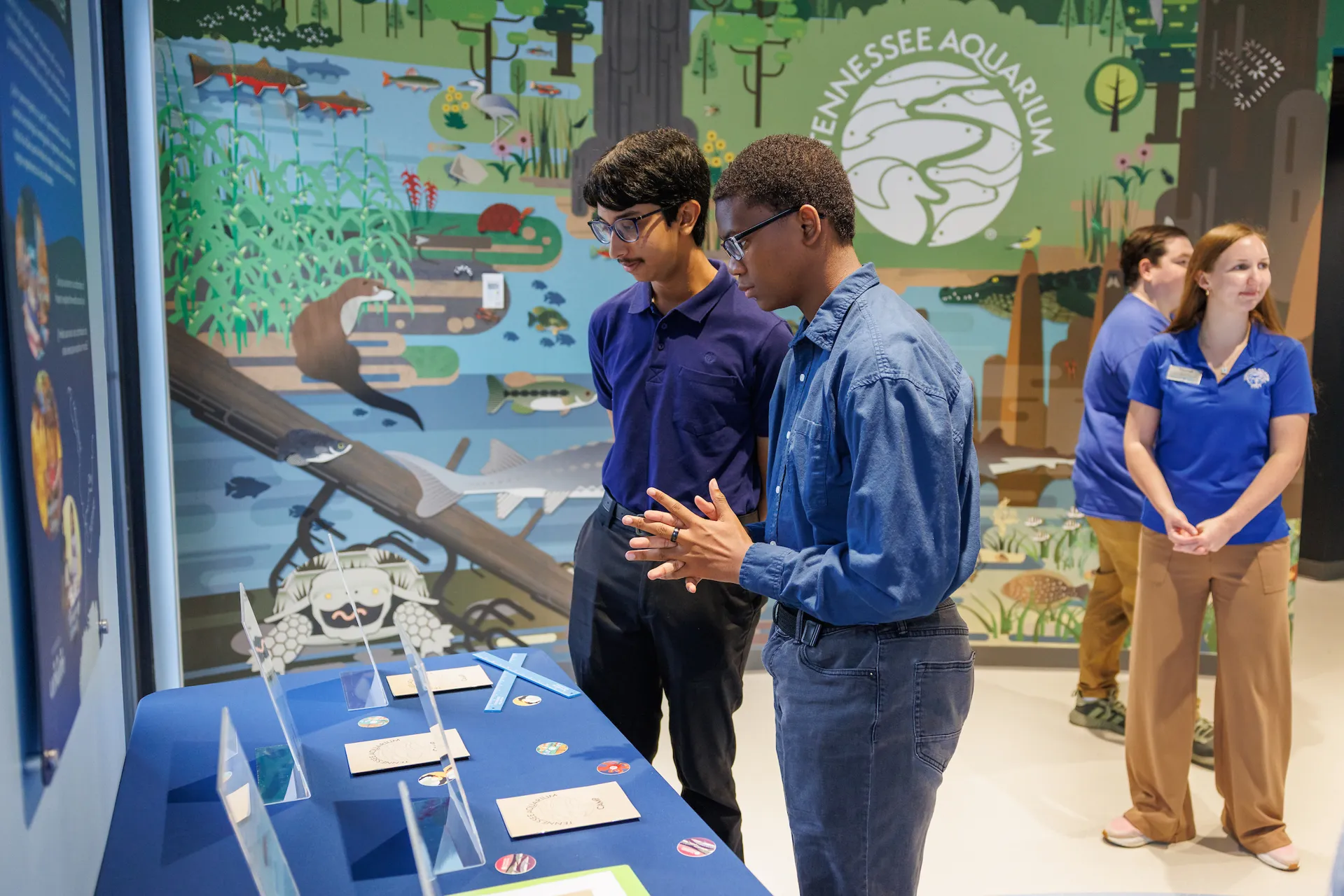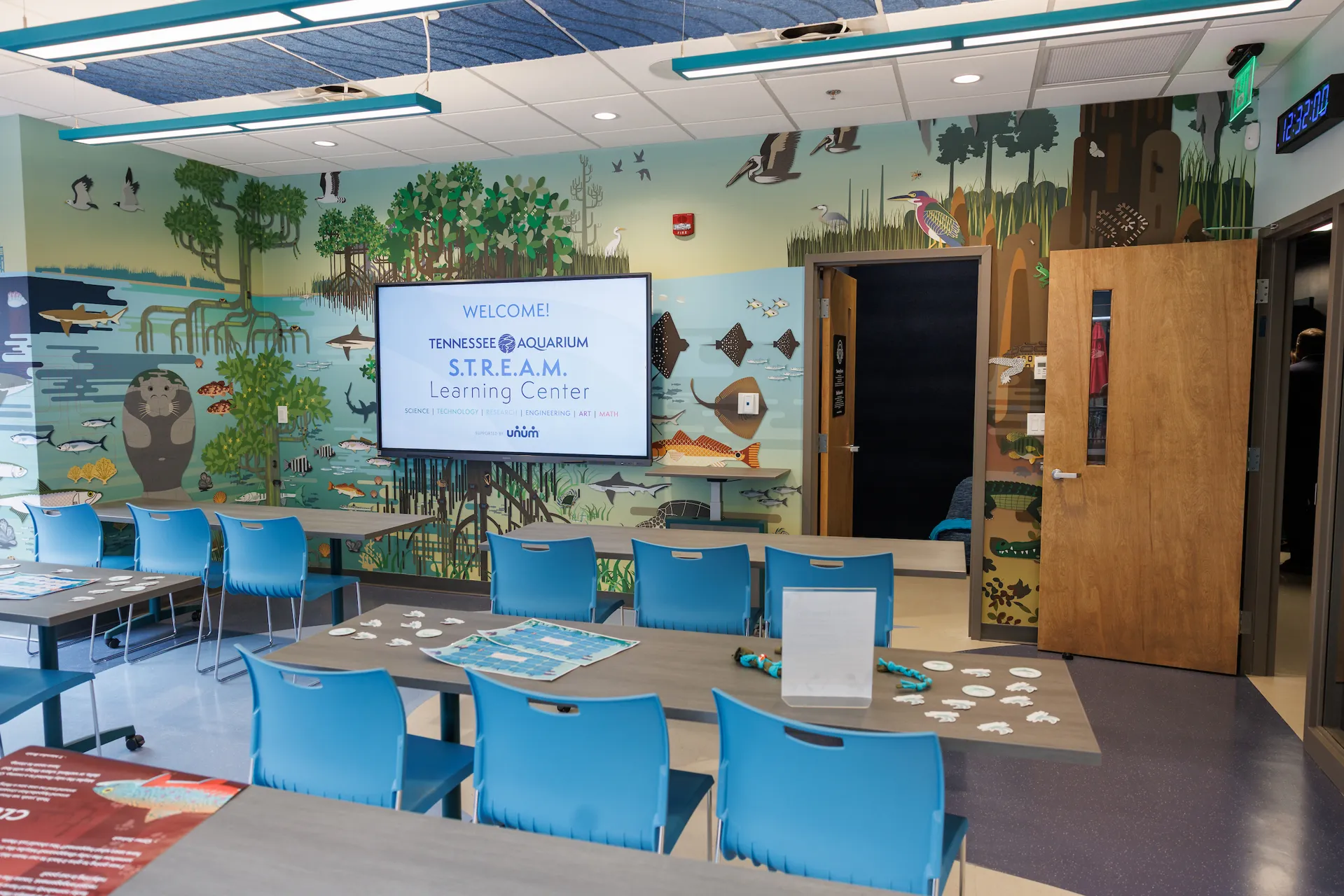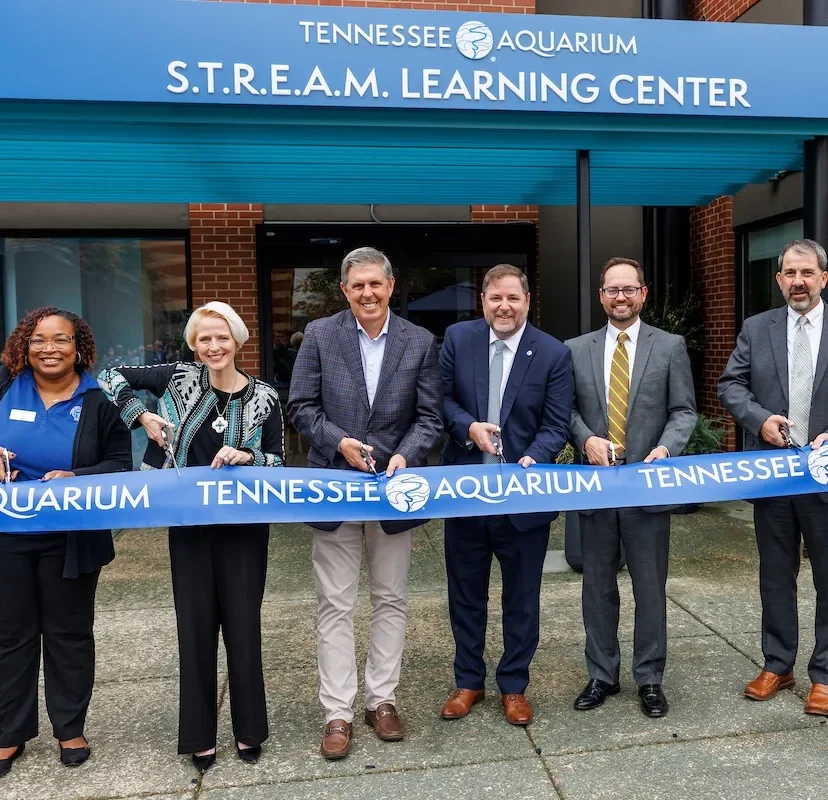Newly opened Learning Center to act as hub of Tennessee Aquarium’s educational activity
Chattanooga, Tenn. (Nov. 20, 2025) – From “learn-play” focused seasonal camps and community outreach programs to in-stream workshops for science teachers, the Tennessee Aquarium has been a tremendous educational resource in the region for more than 30 years.
Despite broadening minds and shaping career trajectories for millions of students and countless educators, however, the Aquarium’s vast educational resources have never been housed in a centralized hub. Educator offices, classroom spaces, and programming venues historically have been scattered throughout the Aquarium’s downtown campus.
Today, however, the Aquarium’s educational programming finally has a new home: The S.T.R.E.A.M. Learning Center, supported by Unum.
With its grand opening today, this spacious new, purpose-built facility on the Aquarium plaza will act as the Aquarium’s educational epicenter — one with prominence equal to its impact.
“Being on the Plaza is something we’re very excited about,” says Natali Rodgers, the Aquarium’s director of learning and evaluation. “I think being more visible will help spread awareness of our work and impact.
“As people see groups go into this space, I think it will pique their curiosity about ‘What’s happening over there?’ It will help them better connect with our work. I’m just excited for all the opportunities that are going to come out of this new education space.”

The new Learning Center occupies the site of a food court previously located adjacent to the Aquarium’s River Journey and Ocean Journey buildings. The former eatery has been completely transformed into a vibrant place where students and teachers can learn and grow while exploring topics associated with Science, Technology, Research, Engineering, Art, and Math (S.T.R.E.A.M.).
The construction of the S.T.R.E.A.M. Learning Center was generously supported by Unum Group.
“Through our partnership with the Tennessee Aquarium and the S.T.R.E.A.M. Learning Center, we’re giving kids real-world experiences that spark curiosity,” says Rick McKenney, Unum’s CEO. “Hands-on learning inspires students and sets the stage for their future success—and that’s something we’re proud to support.”
The last major addition to the Aquarium’s campus took place in October 2016 when the doors opened on the headquarters of the Tennessee Aquarium Conservation Institute (TNACI).
TNACI’s new home brought the Aquarium’s previously decentralized conservation programs, research, and field work under a single roof. It also allowed the Aquarium to serve as a convening location for groups pursuing similar conservation work throughout the Southeast.
The S.T.R.E.A.M. Learning Center is poised to play a similar role in highlighting and amplifying the Aquarium’s role as an educational resource, says Aquarium President & CEO Andy Wood.
“Education sits alongside conservation, guest experience, and community engagement as a pillar of the Aquarium’s mission,” Wood says. “To finally have this beautiful new facility that puts education front and center on our plaza is really exciting.”

Occupying about 4,500 square feet, the S.T.R.E.A.M. Learning Center’s layout features a trio of flexible classroom spaces, including a well-equipped lab focused on STREAM-related activities.
The building’s design was directly influenced by the Aquarium’s educators. Their input led to the incorporation of features such as ambassador animal habitats, additional storage, water bottle refilling stations, and a pair of low stimulation “sensory rooms” to meet the needs of visitors living with autism, PTSD, ADHD, or similar sensory challenges.
Each of the center’s teaching spaces is dominated by vivid, floor-to-ceiling murals depicting specific habitats, including an estuary, forest, and ocean. Created by the Aquarium’s graphic designers, the murals are packed with whimsical, stylized animal illustrations that incorporate — again thanks to input from educators — teachable elements such as a true-to-life-size osprey nest and the inclusion of non-native animals to spark discussions about invasive species.
In a sense, shaping the S.T.R.E.A.M. Learning Center around staff input was a bit like letting teachers design their own school, Rodgers says.
“It was important to me to make sure our education team was a part of this process because, who’s facilitating the majority of these programs? It’s them,” she says. “Making sure they were part of that process and that their perspectives are reflected in that process was critical to me.”
In addition to facilitating the work of the Aquarium’s education staff, a key focus of the S.T.R.E.A.M. Learning Center is to create more opportunities for educators to expand their skill set and credentials through professional development.
In creating relationships with teachers and providing them with what they actually need to be more effective, Rodgers says, the Aquarium can better ensure that it impresses a sense of connection to the natural world on future generations of students.
“It’s very important for us to make sure we get feedback from educators,” she explains. “I don’t want to design programs that are not usable because they won’t have any impact.
“I think it’s very important for us to make sure teachers’ voices are at the table as we’re talking about co-designing. That way, it becomes more of a partnership; we’re building authentic relationships with them.”
“When we talk about opportunities for our kids, we say that opportunity comes by design, meaning there is intentional effort to create opportunity,” says Hamilton County Schools Superintendent Dr. Justin Robertson during today’s ribbon-cutting ceremony. “When Andy talked about what his education team was doing here, he wasn’t talking about this space. He was talking about the intentional design that is going to create opportunities for our kids. We’re excited about what this means for our kids across Hamilton County.”
To learn more about the Aquarium’s educational activity and digital resources for teachers, visit tnaqua.org/educators
Listen to a lengthy discussion about S.T.R.E.A.M. Learning Center with the Aquarium’s director of learning and evaluation on the latest episode of the Aquarium’s official podcast, The Podcast Aquatic, at tnaqua.org/podcast
